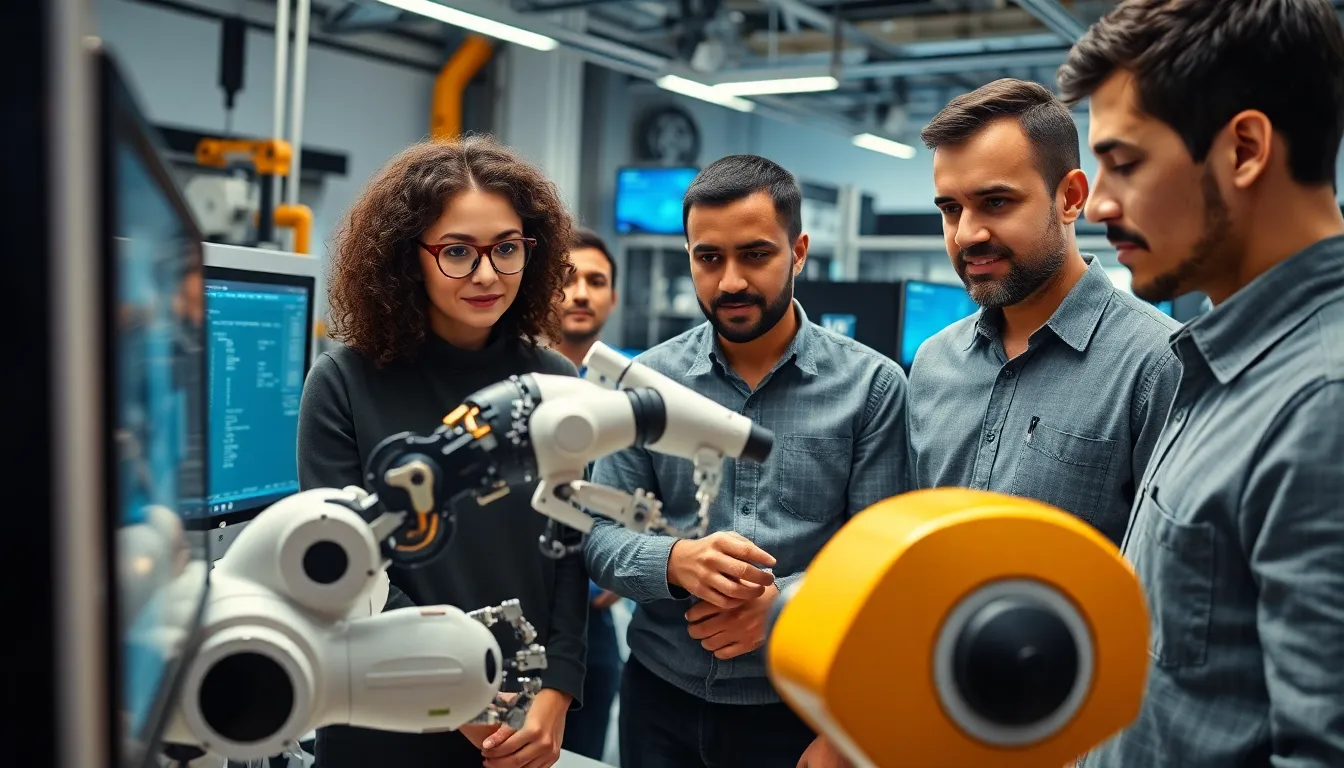Table of Contents
ToggleIn an age where technology shapes daily life, robotics programming stands at the forefront of innovation. As machines become increasingly integral to various industries, understanding how to program these intelligent systems is essential. From manufacturing to healthcare, robotics programming empowers individuals to create solutions that enhance efficiency and productivity.
This dynamic field combines elements of computer science, engineering, and artificial intelligence, making it a fascinating area for both beginners and seasoned professionals. By mastering robotics programming, one can unlock the potential to design robots that perform complex tasks, adapt to new environments, and even learn from their experiences. The journey into robotics programming not only opens doors to exciting career opportunities but also fuels creativity and problem-solving skills in a rapidly evolving technological landscape.
Overview of Robotics Programming
Robotics programming involves creating software that directs robotic systems on how to perform specific tasks. It combines elements from several fields, including computer science, engineering, and machine learning. Understanding robotics programming spans various tasks, from simple automation to complex interactions with the environment.
Robots operate through a series of programmed instructions, enabling them to execute tasks like assembling products, navigating spaces, and assisting in surgical procedures. These systems rely on algorithms that process data from sensors, facilitating real-time responses to external stimuli.
Key programming languages in robotics include:
- Python: Popular for its simplicity and extensive libraries, making it suitable for rapid development and prototyping.
- C++: Favored for performance and efficiency, particularly in systems requiring real-time processing.
- Robotics Operating System (ROS): Provides tools and libraries for building robot applications, promoting modular design and code reuse.
Robotics programming emphasizes problem-solving and logical thinking. Developers continuously refine algorithms to improve robot performance and adaptability. Various platforms, such as simulators and development kits, enhance learning opportunities, allowing developers to experiment and innovate.
The ongoing advancements in artificial intelligence and machine learning significantly impact robotics programming. These technologies enable robots to learn from data, improving their ability to perform complex tasks autonomously. As a result, robotics programming presents vast opportunities across industries, contributing to increased efficiency and effectiveness in operations.
Key Programming Languages in Robotics


Robotics programming relies on several key programming languages that enhance robot functionality and efficiency. Each language offers unique benefits suited for different aspects of robotics.
Python
Python stands out for its simplicity and readability, making it an ideal choice for beginners and experienced developers. It features an extensive set of libraries, such as NumPy and OpenCV, which facilitate complex computations and image processing. Python’s versatility supports various robotic applications, from scripting and automation to machine learning tasks. The strong community around Python also contributes to a wealth of resources and frameworks, like ROSPy, that streamline the development of robotic systems.
C++
C++ is renowned for its performance and efficiency, particularly in high-speed applications. Its ability to manage hardware and execute real-time tasks makes it essential for robotics programming. C++ supports object-oriented programming, enabling developers to create modular and reusable code. Many robotic systems, including the Robotics Operating System (ROS), leverage C++ for critical components that require fine control over system resources. Its efficiency in processing low-level data allows for advanced control algorithms and responsive robotics operations.
Java
Java provides cross-platform capabilities and robust memory management, making it suitable for large-scale robotic applications. Its object-oriented nature promotes modular programming, which enhances maintainability and scalability. Java’s compatibility with various devices and its use in Android-based robotics systems expand its applicability in robotics. Furthermore, libraries like Java Robot facilitate user interface creation and interaction with hardware components, allowing for smoother integration in robotic systems.
Essential Tools and Frameworks
Robotics programming relies on a variety of tools and frameworks that enhance functionality and streamline the development process.
Robot Operating System (ROS)
Robot Operating System (ROS) serves as a flexible framework for writing robot software. It provides essential services such as hardware abstraction, low-level device control, implementation of commonly used functionality, and message-passing between processes. ROS features a rich ecosystem of libraries and tools, enabling developers to create complex robotic applications with ease. Its modular architecture supports the design of reusable components, facilitating the integration of third-party packages and community contributions. With widespread adoption, ROS acts as the standard for robotics programming, fostering collaboration and innovation across the field.
Gazebo Simulation
Gazebo simulation offers a powerful tool for testing and developing robotic systems in a 3D environment. It provides realistic rendering of environments, dynamic simulations, and sensor feedback, allowing developers to assess robot performance before deploying hardware. Gazebo supports a wide range of sensors and models, enabling accurate simulation of real-world interactions. This simulation platform integrates seamlessly with ROS, facilitating straightforward transitions between simulated and real-world tests. Utilizing Gazebo minimizes development time and reduces risks associated with hardware testing, making it an essential resource for robotics programmers.
Applications of Robotics Programming
Robotics programming plays a vital role in numerous sectors, streamlining processes and enhancing productivity. Prominent applications include industrial automation, healthcare robotics, and autonomous vehicles.
Industrial Automation
Industrial automation relies heavily on robotics programming to improve efficiency and reduce labor costs. Robots automate tasks such as assembly, packaging, and quality control, ensuring consistency and precision. Programmable logic controllers (PLCs) manage robots’ operations in factories, enabling real-time adjustments based on production requirements. Industrial robots, programmed with advanced algorithms, excel in tasks like welding and painting, enhancing throughput and minimizing human error.
Healthcare Robotics
Healthcare robotics incorporates programming to assist in surgical procedures, rehabilitation, and patient monitoring. Surgical robots, equipped with precise instruments, perform minimally invasive surgeries, allowing for quicker recovery times and reduced hospital stays. Robotic exoskeletons aid in rehabilitation, helping patients regain mobility through programmed motion patterns. Additionally, service robots provide support in hospitals, delivering medications and transporting supplies, alleviating staff workloads while improving operational efficiency.
Autonomous Vehicles
Autonomous vehicles harness robotics programming to navigate environments safely and efficiently. Programming focuses on real-time data processing from sensors, enabling vehicles to assess surroundings and make informed driving decisions. Algorithms facilitate path planning, obstacle avoidance, and traffic management, ensuring compliance with road rules. Self-driving technology, developed through robotics programming, enhances transportation systems by reducing accidents, improving traffic flow, and paving the way for smart city initiatives.
Challenges in Robotics Programming
Robotics programming faces several challenges that impact development and implementation across industries. These challenges include technical limitations and ethical considerations that require careful attention by developers and engineers.
Technical Limitations
Technical limitations arise from factors such as sensor precision, computational power, and algorithm complexity. Robots rely on sensors to receive environmental data, and inaccuracies can lead to operational failures. For instance, a malfunctioning sensor may cause an autonomous vehicle’s navigation system to misinterpret obstacles, risking safety.
High computational power is essential for executing complex algorithms, especially for tasks requiring real-time decision-making. The processing capabilities of onboard computers can restrict performance in robots performing intensive tasks. Developers might encounter challenges when trying to enhance functionalities within the constraints of available hardware.
Moreover, algorithm complexity presents challenges in optimizing robot behavior. Developing algorithms that allow robots to learn from data can be resource-intensive. Balancing efficiency and accuracy becomes crucial, particularly in environments where rapid responses are critical.
Ethical Considerations
Ethical considerations play a vital role in robotics programming, addressing the implications of autonomous systems on society. Safety concerns emerge with the deployment of robots in public spaces, especially autonomous vehicles and surgical robots. Accidents resulting from programming errors raise questions about accountability and liability.
Data privacy stands as another significant ethical issue. Robots equipped with data-collection capabilities can inadvertently gather sensitive information. Developers must ensure robust data protection measures when designing systems to comply with legal standards and safeguard user privacy.
Additionally, the potential impact on employment poses ethical challenges as automation increases in various sectors. As robots take over tasks traditionally performed by humans, it’s important to consider the broader social implications, including job displacement and economic inequality. Developers must navigate these complex ethical landscapes as they create intelligent systems.




